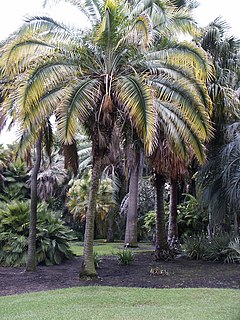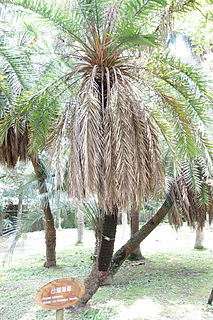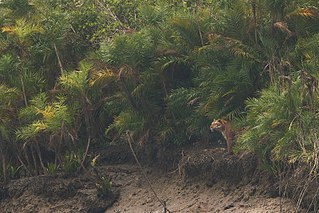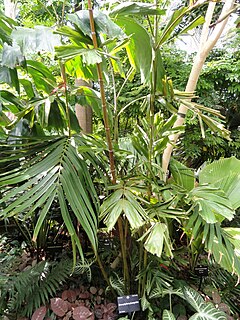
Phoenix is a genus of 14 species of palms, native to an area starting from the Canary Islands in the west, across northern and central Africa, to the extreme southeast of Europe (Crete), and continuing throughout southern Asia from Turkey east to southern China and Malaysia. The diverse habitats they occupy include swamps, deserts, and mangrove sea coasts. Most Phoenix species originate in semiarid regions, but usually occur near high groundwater levels, rivers, or springs. The genus is unusual among members of subfamily Coryphoideae in having pinnate, rather than palmate leaves; tribe Caryoteae also have pinnate or bipinnate leaves.

Washingtonia is a genus of palms, native to the southwestern United States and northwest Mexico. Both Washingtonia species are commonly cultivated across the Southern United States, the Middle East, southern Europe, and north Africa, where they have greatly hybridized.

Phoenix reclinata, the wild date palm or Senegal date palm, is a species of flowering plant in the palm family native to tropical Africa, the Arabian Peninsula, Madagascar and the Comoro Islands. It is also reportedly naturalized in Florida, Puerto Rico, Bermuda and the Leeward Islands. The plants are found from sea level to 3000 m, in rain forest clearings, monsoonal forests and rocky mountainsides.

Metroxylon is a genus of monoecious flowering plants in the Arecaceae (palm) family, consisting of seven species. They are native to Western Samoa, New Guinea, the Solomon Islands, the Moluccas, the Carolines and Fiji in a variety of habitats, and cultivated westward to Thailand and Malaya.

Phoenix rupicola or cliff date palm is a species of flowering plant in the palm family, native to the mountainous forests of India and Bhutan from 300 to 1200 m, usually occurring on cliffs, hillsides and similar terrain. It is threatened by habitat loss in its native range. On the other hand, the species is reportedly naturalised in the Andaman Islands, the Leeward Islands, Cuba and Puerto Rico and a specimen has recently been reported in Saint Lucia.

Phoenix acaulis the dwarf date palm or stemless date palm, is a species of flowering plant in the palm family, native to northern India, Bhutan and Nepal. Found in altitudes from 350 to 1500 m, Phoenix acaulis grows in scrubland, savannas and in pine forests. Trunks in this species remain underground or, at most, grow to a few inches in height. Leaves are 1.5 m long, gray-green, with 25 cm, pinnately arranged leaflets on short, armed petioles.

Phoenix andamanensis is a wild relative of date palm endemic to the Andaman Islands in the Bay of Bengal southwest of Myanmar. It is rather a newly described taxon by Sasha C. Barrow in 1998 based on old herbarium collections. This taxon was known only from a few herbarium collections and a few insignificant citations by Kurz in 1870, Brandis in 1906 and Parkinson in 1923. The Herbarium collections were made mostly during the British regime in 1903, 1904 and 1911 by Rogers and Osmaton. Later, Ellis from the Botanical Survey of India in 1990 collected one specimen from the Saddle Peak. The specimens were remained unidentified at herbaria until its circumscription as new taxon by Barrow in 1998.
Phoenix caespitosa is a species of flowering plant in the palm family native to the Arabian Peninsula and the deserts of Somalia. This species grows in large clumps near oases or underground springs. The trunks are short, often subterranean, in readily clumping clusters with 3 m leaves divided into 15 to 45 cm, bluish-green leaflets.

Phoenix loureiroi is a species of flowering plant in the palm family, indigenous to southern Asia, from the Philippines, Taiwan, India, southern Bhutan, Burma, Thailand, Cambodia, Vietnam, Pakistan, and China. It occurs in deciduous and evergreen forests and in clear terrain from sea level to 1,500 m altitude.

Phoenix paludosa, also called the mangrove date palm, is a species of flowering plant in the palm family, indigenous to coastal regions of India, Bangladesh, Myanmar, Thailand, Cambodia, Sumatra, Vietnam and peninsular Malaysia. They are also known as Sea Dates. The trees grow in clusters, to 5 m high, usually forming dense thickets. The leaves are 2 to 3 m long and recurved.

Phoenix sylvestris also known as silver date palm, Indian date, sugar date palm or wild date palm, is a species of flowering plant in the palm family native to southern Pakistan, most of India, Sri Lanka, Nepal, Bhutan, Myanmar and Bangladesh. It is also reportedly naturalized in Mauritius, the Chagos Archipelago, Puerto Rico and the Leeward Islands. Growing in plains and scrubland up to 1300 m above sea level, the fruit from this palm species is used to make wine and jelly. The sap is tapped and drunk fresh or fermented into toddy. The fresh sap is boiled to make palm jaggery in West Bengal state of India and Bangladesh.

Bismarckia is a monotypic genus of flowering plant in the palm family endemic to western and northern Madagascar where they grow in open grassland. The genus is named for the first chancellor of the German Empire Otto von Bismarck and the epithet for its only species, Bismarckia nobilis, comes from Latin for 'noble'.

Allagoptera is a monoecious genus of flowering plant in the palm family found in South America consisting of 5 accepted species. Compared to other genera within the Cocoseae Allagoptera is described as particularly specialized. The genus name is a Greek combination of "change" and "feather", describing the full leaf; it was formerly named Diplothemium.
Brassiophoenix is a monoecious genus of flowering plant in the palm family found in Papua New Guinea. Of the two similar species, one is more common in cultivation and was mistakenly identified as Brassiophoenix schumannii. In 1999, Zona and Estig showed that the commonly cultivated species was instead the type species Brassiophoenix drymophoeoides. The two species are distinguished by their separated geographical locations and minor differences in fruit form. The genus name is a combination of the surname Brass, honoring the first collector L.J. Brass, and Phoenix, another palm genus.

Actinorhytis is a monotypic genus of flowering plant in the palm family found in Oceania and southeast Asia. The lone species, Actinorhytis calapparia is a rain forest inhabitant and has very large fruit. The genus name is from two Greek words meaning 'ray' and 'fold' which describe the endosperm of the seed.

Dictyocaryum is a monoecious genus of flowering plant in the palm family found in South America. It is closely related to the genus Iriartea; they are commonly called araque or palma real. As many as eleven species have been described but this number is reduced to three in most current accounts. The genus name translates from two Greek words meaning "net" and "nut", describing the thick network of raphe fibers around the seed.

Hydriastele is a diverse and widespread genus of flowering plant in the palm family found throughout Australia and New Zealand, Melanesia, Polynesia, and Southeast Asia. It consisted of just nine species until 2004, when molecular research, supported by morphologic similarities, led taxonomists to include the members of the Gulubia, Gronophyllum, and Siphokentia genera. 48 species are now recognized, of which 38 are new combinations, two are new names and one is a new species. It is named in Greek, combining "hydriad", a water nymph in mythology, and "column".

Laccospadix is a monotypic genus of flowering plant in the palm endemic to Queensland. Only one species is known, Laccospadix australasicus, commonly called Atherton palm or Queensland kentia. The two Greek words from which it is named translate to "reservoir" and "spadix".
Lepidocaryum is a monotypic genus of flowering plant in the palm family from South America where the lone species, Lepidocaryum tenue, is commonly called poktamui. Nine species names have been published, but palm taxonomists currently agree that just one variable species includes them all. The most reduced member of the Lepidocaryeae, it is similar in appearance to three closely related genera, Mauritia, Mauritiella, and Lytocaryum. The genus name combines the Greek words for "scale" and "nut" and the species epithet is Latin for "thin".

Myrialepis is a monotypic genus of flowering plant in the palm family, the single species,Myrialepis paradoxa, native to Southeast Asia. The genus name is a combination of the Greek words meaning "innumerable" and "scale", a description of the fruit, and the epithet is Latin for "paradox".

















